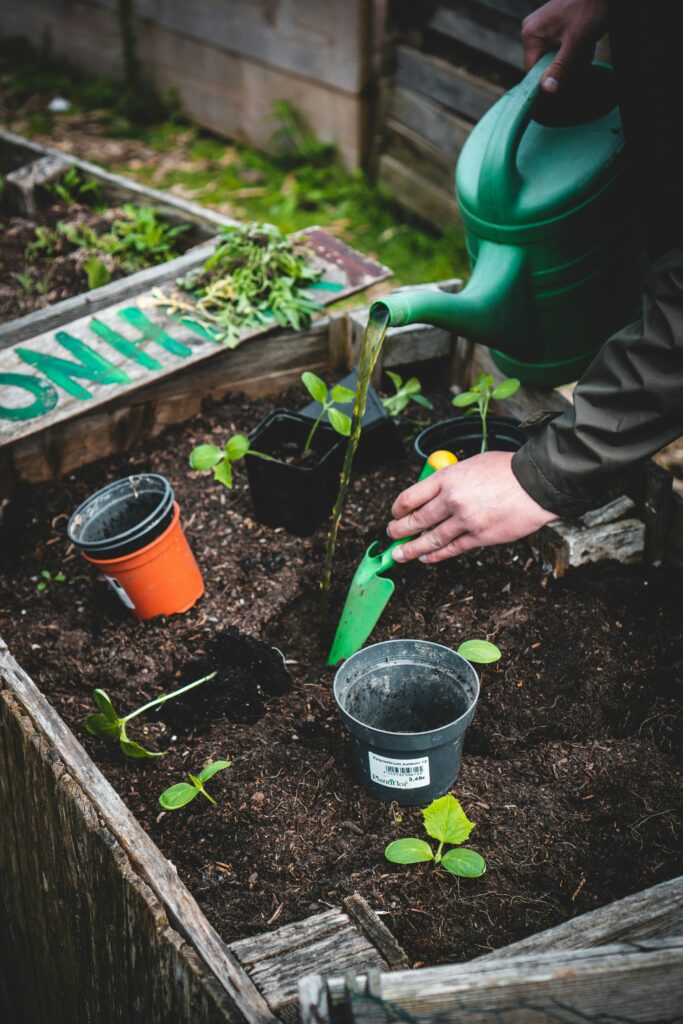Disclosure: As participants in the Amazon Associates Program, we earn from qualifying purchases. This means when you click on an Amazon link on this page and make a purchase, we receive a commission. This doesn’t affect the price you pay but it does help us to keep producing the content you love to see. We always aim for honesty and transparency in everything we do, and your support means the world to us. Thank you for helping us grow and for being part of our community.
Imagine stepping into a digital garden, where every click blossoms into a wealth of knowledge and inspiration for vertical gardening enthusiasts. Our website is dedicated to the green, upwardly mobile world of vertical garden kits. Here, we curate articles that educate, inspire, and empower gardeners of all levels to transform their limited living spaces into lush vertical oases. From setting up your first vertical garden kit to exploring the latest trends in vertical horticulture, our platform covers it all. We provide detailed product reviews, practical tips, and tricks, and foster a community where green thumbs can share their experiences. Our mission is to empower you to make the most of your vertical spaces and create greener, more sustainable environments, one vertical garden at a time. Welcome to “Small Space, Big Yield: Vertical Garden Success Stories.”

This image is property of images.unsplash.com.
Introduction
Welcome to our comprehensive guide on vertical gardening! If you have a limited space but a big green thumb, vertical gardening is the perfect solution for you. In this article, we will explore the benefits of vertical gardening, help you choose the right vertical garden kit, guide you through the setup process, provide maintenance tips, and offer design ideas to inspire your creativity. We will also share success stories of vertical gardens in small spaces and provide tips for maximizing your yield. Finally, we will address common challenges and offer solutions to ensure your vertical garden thrives. Let’s dive in!
The Benefits of Vertical Gardening
Maximizing limited space
One of the greatest advantages of vertical gardening is that it allows you to maximize your space. Whether you have a small balcony, a tiny backyard, or even just a wall indoors, vertical gardening utilizes vertical space, making it possible to grow a variety of plants without taking up precious horizontal space. By utilizing the vertical dimension, you can create a thriving garden even in the smallest of spaces.
Improved air quality
Vertical gardens not only enhance the aesthetic appeal of your surroundings but also improve the quality of air. Plants naturally purify the air by absorbing carbon dioxide and releasing oxygen through photosynthesis. Vertical gardens, with their increased surface area, provide a larger plant population, resulting in improved air quality. Breathing in fresh air filled with oxygen is not only beneficial for your physical health but also has a positive impact on your mental well-being.
Reduced water usage
Vertical gardening allows for efficient water usage, making it an environmentally friendly option. With the right irrigation system, water is delivered directly to the plants’ roots, minimizing evaporation and waste. Vertical gardens also provide shade and reduce soil temperature, decreasing water loss due to evaporation. By conserving water, you can contribute to water conservation efforts and lower your water bills.
Increased accessibility
Traditional gardening can be physically demanding, requiring bending, kneeling, and reaching to tend to plants. Vertical gardening, on the other hand, offers increased accessibility as the plants are at eye level or within easy reach. This makes it ideal for individuals with mobility issues or those who prefer a more accessible gardening experience. With vertical gardening, you can enjoy the pleasures of gardening without straining your body.
Enhanced aesthetics
Vertical gardens bring a touch of beauty, vibrancy, and life to any space. They can transform dull walls into living tapestries, adding a refreshing and calming ambiance to your surroundings. With the ability to choose from a wide variety of plants, colors, and textures, you can create a visually stunning and personalized vertical garden that complements your style and taste. Whether you opt for luscious greenery, colorful blooms, or a combination of both, your vertical garden will be a striking focal point wherever it is installed.

This image is property of images.unsplash.com.
Choosing the Right Vertical Garden Kit
To get started with your vertical gardening journey, it is essential to choose the right vertical garden kit. Consider the following factors when selecting a kit:
Consider your space limitations
Before purchasing a vertical garden kit, assess the available space you have. Measure the dimensions of the area where you intend to install the garden and ensure that the kit you choose fits within those dimensions. Consider the weight limitations of your wall or structure to ensure it can support the weight of the kit when it’s fully planted.
Select the appropriate plant type
Different plants have different growth habits, light requirements, and water needs. Consider the location of your vertical garden and choose plants that are well-suited to that environment. If you have limited sunlight, opt for shade-loving plants. If your space receives ample sunlight, select plants that thrive in full sun. Additionally, choose plants that have similar water and maintenance requirements to ensure ease of care.
Evaluate the kit’s design and materials
Vertical garden kits come in various designs and materials. Evaluate the design to ensure it suits your aesthetic preferences and complements your space. Consider the material used for the planting containers – plastic, fabric, or other materials – and choose one that is durable, resistant to weather conditions, and allows for proper drainage.
Assess the irrigation system
An efficient irrigation system is crucial for the success of your vertical garden. Look for kits that provide a reliable irrigation system, such as built-in drip lines or self-watering containers. A well-designed irrigation system will ensure that water is distributed evenly to all plants, preventing over or under-watering.
Read customer reviews and ratings
Before making a final decision, take the time to read customer reviews and ratings of different vertical garden kits. You can gain valuable insights from others who have purchased and used the kits. Pay attention to feedback regarding ease of assembly, durability, and overall satisfaction.
Setting Up Your Vertical Garden
Now that you have chosen the right vertical garden kit, it’s time to set it up and bring your vertical garden to life. Follow these steps to set up your vertical garden:
Prepare the chosen location
Clear the chosen location by removing any debris or obstructions. If you are installing your vertical garden indoors, protect the surrounding area with a drop cloth to catch any excess soil or water during the setup process.
Install the supporting structure
Depending on the kit you have chosen, you may need to install a supporting structure. This could be a wall-mounted trellis, a freestanding frame, or any other structure that will hold your vertical garden securely in place. Follow the manufacturer’s instructions for installation.
Arrange the planting containers
Once the supporting structure is in place, arrange the planting containers according to your desired design. Consider factors such as plant height, spacing, and aesthetic appeal. Some kits may come with pre-determined layouts, while others allow for more flexibility in arranging the containers.
Fill the containers with suitable soil
Use a high-quality potting mix or a soilless medium to fill the planting containers. Ensure that the soil is well-draining to prevent waterlogging and root rot. Different plants may have specific soil requirements, so consider the plant types you have chosen when selecting the soil.
Carefully plant your chosen crops
Remove each plant from its nursery container or seedling tray and gently loosen the roots. Plant each individual plant in its designated container, ensuring that the root ball is covered with soil and the plant is positioned securely. Leave enough space between plants for adequate growth and airflow.
Water and fertilize appropriately
Give your newly planted vertical garden a thorough watering to settle the soil and provide moisture to the roots. Follow the watering guidelines for each plant type, as different plants have varying water needs. Additionally, consider fertilizing your vertical garden regularly to promote healthy growth and nourishment. Use a balanced fertilizer or organic alternatives, following the package instructions.

This image is property of images.unsplash.com.
Vertical Garden Maintenance
To ensure that your vertical garden thrives, regular maintenance is essential. Follow these key maintenance tasks to keep your vertical garden in optimal condition:
Regular watering and irrigation
Monitor the moisture levels in your vertical garden and water accordingly. Vertical gardens tend to dry out faster than traditional gardens, so check the soil moisture frequently. Use the irrigation system provided by your kit or water manually if required. Ensure that water is reaching all plants evenly, paying attention to plants at the top and bottom of the vertical garden.
Pruning and trimming
As your plants grow, pruning and trimming become necessary to maintain their shape, promote healthy growth, and prevent overcrowding. Remove any dead or damaged foliage and trim back excessive growth. Pruning not only keeps your vertical garden aesthetically pleasing but also improves air circulation and reduces the risk of diseases and pests.
Pest and disease management
Just like traditional gardens, vertical gardens are susceptible to pests and diseases. Regularly inspect your plants for signs of pest infestation or disease. Treat any issues promptly to prevent further damage. Utilize organic pest control methods as much as possible to maintain the health of your plants and minimize the use of harsh chemicals.
Fertilizing
To ensure the ongoing health and vigor of your vertical garden, regular fertilizing is essential. Follow the fertilizing schedule recommended for your specific plants. Consider using slow-release fertilizers or organic alternatives to provide a steady supply of nutrients to your plants over time.
Monitoring and adjusting light exposure
Plants have varying light requirements, so it is important to monitor the light exposure your vertical garden receives. If certain plants are not thriving due to insufficient or excessive light, consider adjusting their position within the vertical garden. For indoor vertical gardens, supplementing natural light with artificial lighting may be necessary to provide the optimal light conditions for your plants.
Vertical Garden Design Ideas
Now that your vertical garden is thriving, let’s explore some design ideas to inspire your creativity:
Creating a herb wall
Transform your kitchen or outdoor wall into a delightful herb garden. Plant an assortment of flavorful herbs such as basil, rosemary, thyme, and mint. Not only will this design idea provide you with a fresh supply of herbs for cooking, but it will also infuse your space with delightful aromas.
Building a succulent tapestry
Succulents are renowned for their low maintenance and striking beauty. Choose an array of succulent varieties with different shapes, colors, and textures, and arrange them in a tapestry-like pattern on your vertical garden. This design idea will create a stunning focal point in any space.
Growing a vertical vegetable garden
Maximize your food production by growing a vertical vegetable garden. Select compact vegetable varieties such as cherry tomatoes, lettuce, peppers, and cucumbers that can thrive in a vertical setting. This design idea is perfect for those who want to enjoy fresh and organic vegetables right at their fingertips.
Designing a floral masterpiece
Bring life and color to your vertical garden by creating a floral masterpiece. Choose a combination of flower varieties that bloom at different times, ensuring year-round color and vibrancy. From radiant sunflowers to delicate roses, your vertical garden will be a floral paradise.
Incorporating vertical garden art installations
For a truly unique and artistic vertical garden, consider incorporating art installations within the design. Hang decorative pieces, such as metal sculptures or colorful glass ornaments, to add visual interest and create a conversation piece.

Success Stories in Small Spaces
Vertical gardening has revolutionized the way we think about gardening in small spaces. Here are some success stories to inspire you:
Balcony gardens in urban apartments
Many individuals living in urban apartments have turned their balconies into thriving green spaces. With careful planning and the right vertical garden kit, urban dwellers have successfully grown a variety of plants, from herbs and vegetables to flowers and succulents. Balcony gardens not only provide a source of fresh produce but also create a peaceful oasis in the midst of the city.
Vertical gardens in office spaces
Office environments can often lack greenery and natural elements. Vertical gardens have been introduced to office spaces to improve air quality, enhance aesthetics, and boost employee morale. By incorporating vertical gardens into their workspace, companies have created a healthier and more vibrant atmosphere.
Community gardens in residential complexes
Residential complexes have embraced the concept of community gardens, where residents come together to cultivate and maintain vertical gardens. These gardens create a sense of community, foster relationships, and provide an opportunity for residents to connect with nature and each other.
Vertical farms in commercial buildings
To address the increasing demand for fresh produce, vertical farms have emerged in commercial buildings. By utilizing vertical gardening techniques, these farms are able to grow vegetables and herbs in controlled environments, optimizing space and resources. Vertical farming contributes to sustainable agriculture practices and reduces the need for long-distance transportation of produce.
Tips for Maximizing Yield
To ensure a bountiful harvest from your vertical garden, consider the following tips:
Choose high-yield crop varieties
Select crop varieties that are known for their high yield. This will ensure that you get the maximum amount of produce from your vertical garden. Research different varieties and choose those that are well-suited to your specific climate and growing conditions.
Implement companion planting techniques
Companion planting involves growing compatible plant species together to maximize their growth and health. Certain plants have natural synergies that can deter pests, enrich the soil, or provide support to each other. Research companion planting techniques to optimize the productivity of your vertical garden.
Optimize light exposure
Ensure that your plants receive adequate light by positioning your vertical garden in the sunniest spot available. If natural light is limited, consider using supplementary grow lights to provide the necessary light spectrum for plant growth. Proper light exposure will help your plants thrive and produce an abundance of fruits, vegetables, or flowers.
Practice proper watering and fertilization
Follow a consistent watering schedule to ensure that your plants receive the right amount of moisture. Overwatering or underwatering can negatively affect plant growth and yield. Additionally, fertilize your vertical garden regularly to provide essential nutrients for healthy plant development. Find a balanced fertilizer suitable for your plant types and follow the instructions for application.
Implement pest control measures
Pests can significantly impact plant growth and yield. Regularly inspect your plants for signs of pests and take appropriate action to prevent infestations. Implement organic pest control methods such as companion planting, natural predators, or homemade remedies to protect your plants without the use of harsh chemicals.

Common Challenges and Solutions
Vertical gardening, like any form of gardening, comes with its challenges. Here are some common challenges and solutions to overcome them:
Limited sunlight in certain locations
If your vertical garden is situated in an area with limited sunlight, select plants that thrive in shade or partial shade. Examples include ferns, hostas, and certain types of orchids. Additionally, consider using supplementary grow lights to provide the necessary light spectrum for plant growth.
Insufficient space for root development
Vertical gardens often have limited space for root development. To overcome this challenge, choose plants with smaller root systems or those that are suited for growing in containers. Alternatively, select kits with deeper planting containers or consider using fabric grow bags that allow for better root expansion.
Water drainage issues
Proper water drainage is essential for the health of your plants. If your vertical garden is experiencing water drainage issues, ensure that the containers have sufficient drainage holes. Adjust the soil composition to improve drainage by adding perlite or vermiculite. If necessary, consider elevating the vertical garden slightly to allow excess water to flow freely.
Managing plant overcrowding
As your plants grow, they may start to overcrowd each other, resulting in competition for resources and restricted growth. Regularly monitor your vertical garden and thin out overcrowded plants. Transplant or remove excess plants to provide adequate space for each individual plant to grow and thrive.
Balancing heat and humidity levels
In certain climates, maintaining the right balance of heat and humidity can be a challenge. High temperatures coupled with low humidity can cause plants to wilt or dry out quickly. Consider incorporating shade cloth or installing misting systems to provide relief from excessive heat and increase humidity levels within your vertical garden.
Conclusion
Vertical gardening opens up a world of possibilities for individuals with limited space who have a passion for gardening. The benefits of vertical gardening extend beyond growing beautiful plants. By utilizing vertical space, you can maximize the potential of any small area and create a flourishing green oasis.
From choosing the right vertical garden kit to setting up and maintaining your vertical garden, we have covered all aspects of vertical gardening in this comprehensive article. We hope that our insights, tips, and ideas will inspire and empower you to embark on your vertical gardening journey.
Remember, whether you choose to create a herb wall in your kitchen, build a succulent tapestry, or grow a vertical vegetable garden, the possibilities are endless. With creativity, dedication, and a little bit of know-how, your vertical garden will thrive and bring joy and beauty to your living space.
Join us in embracing the world of vertical gardening and contribute to creating greener, more sustainable environments, one vertical garden at a time. Happy gardening!







